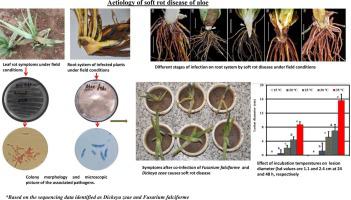Journal of Applied Research on Medicinal and Aromatic Plants ( IF 3.9 ) Pub Date : 2023-05-10 , DOI: 10.1016/j.jarmap.2023.100492 Ram Prasnna Meena , Kunal Mandal , Mital P. Patel , Dipal Minipara , Jatin N. Samanta

|
Soft rot is a devastating disease of aloe and the infected plants developed symptoms of rotting tissues from collar region upwards. Aloe plants artificially inoculated with a Dickeya spp. (reported earlier as the causal agent) at the root zone but did not develop the disease symptoms, eliminating the possibility of pathogen to entering through roots. Besides, a Fusarium spp. was repeatedly isolated from collar regions of the naturally infected plants. Further, it was established that lesions produced due to fungal infection predisposed the subsequent infection of the bacterial pathogen. Sequencing results and phylogenetic analysis based on three partial genes of bacteria (dnaX, icdA and mdh) and fungus (ITS, TEF-1α and RPB-2) confirmed the identity of pathogens as Dickeya zeae and Fusarium falciforme, respectively. An artificial inoculation technique was developed for quick screening of aloe germplasm for resistance of bacterium. Among 40 accessions screened, none was found resistant, however, F. falciforme failed to produce lesion on two accessions (Guj4 and Raj3), consequently making them resistant to soft rot disease upon combined inoculation with both the pathogens. Besides the genetic constituent, rapid rotting was observed at 35 °C but not at and below the 15 °C temperature. In planta, the bacterium concentration increased gradually with the rise of incubation temperature between 15 and 35 °C. The present study suggests possible management aspects of the problem through (i) exploiting host resistance and (ii) escaping post–harvest decay by storing and transporting aloe leaves at temperatures ≤ 15 °C and (iii) avoidance of water stagnation in field.
中文翻译:

与芦荟 (L.) Burm 软腐病相关的病原体的病原学和分子特征。F。
软腐病是芦荟的一种破坏性病害,受感染的植物从领口区域向上出现组织腐烂的症状。用Dickeya spp 人工接种的芦荟植物。(之前报道为病原体)在根区但没有出现病害症状,排除了病原体通过根部进入的可能性。此外,镰刀菌属。从自然感染植物的衣领区域反复分离。此外,已确定由真菌感染产生的损伤预示着细菌病原体的后续感染。基于细菌三个部分基因(dnaX、icdA和mdh)的测序结果及系统发育分析) 和真菌 ( ITS 、 TEF-1α和RPB-2 ) 证实了病原体的身份,分别为Dickeya zeae和Fusarium falciforme 。开发了一种用于快速筛选芦荟种质细菌抗性的人工接种技术。在筛选的 40 个种质中,没有发现抗性,然而,F. falciforme未能在两个种质(Guj4 和 Raj3)上产生病变,因此使它们在与两种病原体联合接种时对软腐病具有抗性。除了遗传成分外,在 35 °C 时观察到快速腐烂,但在 15 °C 和以下温度时没有观察到。在足底,在15~35℃之间,随着培养温度的升高,细菌浓度逐渐增加。本研究提出了该问题的可能管理方面,方法是 (i) 利用寄主抵抗力和 (ii) 通过在 ≤ 15 °C 的温度下储存和运输芦荟叶来避免收获后腐烂,以及 (iii) 避免田间积水。



























 京公网安备 11010802027423号
京公网安备 11010802027423号